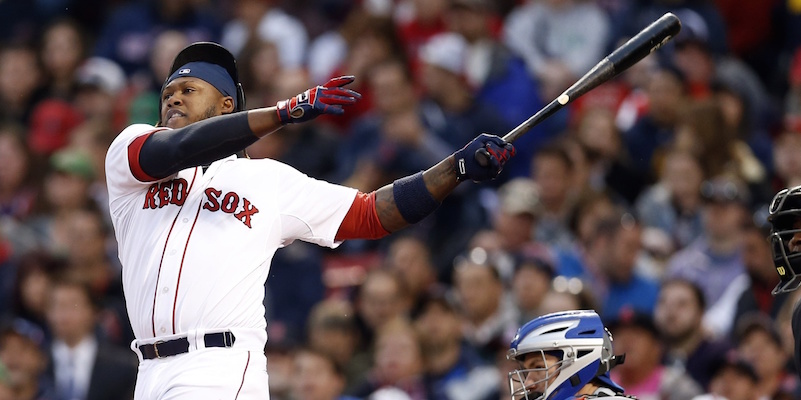The story of last night was Eduardo Rodriguez and his excellent start for a pitching-starved team. Rodriguez won’t be that great every night, no pitcher is or ever has been, but his promise represents an intriguing answer to the Red Sox’s starting pitching woes. However, perhaps lost in the Rodriguez hoopla was the night turned in by Hanley Ramirez. Ramirez went 2-for-4 with a walk, a double, and a home run. The home run is significant in that it is the first Hanley has hit since April 29.
Last night’s was Hanley’s second game in the past month featuring two extra base hits, and that even oversells it a bit as he had but three extra base hits (all doubles) during the entire month of May before last night. From May 9 through May 27, Hanley hit .211/.253/.254, worse than Darren Lewis, worse than Will Middlebrooks, worse than the vast majority of big leaguers because big leaguers don’t stay big leaguers when they put up .507 OPSs.
Two things I haven’t mentioned yet. The first is that what Hanley was doing over the first month of the season was unsustainable. Players don’t hit all home runs and no doubles over the course of the season. They don’t hit the ball as hard (usually, probably) as Hanley hit it over the course of a full season. They don’t post a 40 percent home run-to-fly ball ratio over a full season unless they are Barry Bonds, who Hanley Ramirez is not because he is Hanley Ramirez. Ramirez got off to a great start offensively this season but that’s what it was, not something he was going to continue to do for the rest of the season.
The second thing I didn’t mention yet is Hanley’s shoulder injury. Hanley hurt his left shoulder making what should have been a catch on a James Loney fly ball down the left field line in the first inning of a May 9 game against Tampa. Ramirez caught the ball in stride and took two or three steps before his momentum carried him into the wall, where the impact jarred the ball loose. I’ve injured my shoulder before and it’s difficult enough to throw a baseball let alone swing a bat hard enough to hit a home run.
Ramirez seemed to be in that same boat. Still, he protested whenever reporters brought up the injury as a possible reason for his downturn in production, maintaining that he was healthy and simply not seeing enough hittable pitches. On May 26, Tim Britton of the Providence Journal tweeted an image showing Hanley’s spray charts before and after he hurt his shoulder. It doesn’t take any kind of degree in baseballology to see Ramirez was not pulling the ball after the injury, certainly not with the kind of authority with which he’d displayed prior to hitting the wall.
The timing of Hanley’s injury doesn’t perfectly correspond with the end of the month, but it’s close enough that looking at monthly splits should tell a compelling story. And they do! For example, in April, 41.4 percent of the batted balls Ramirez hit were classified as “hard” hits while in May just 25 percent were “hard.” The interesting part is the hits classified as “soft” were roughly the same, 22.9 percent in April to 25 percent in May, hinting that maybe the problem wasn’t that Ramirez was failing to barrel the ball up adequately but that he wasn’t applying the same force to the ball when he did hit it well.
Maybe the problem wasn’t that Ramirez was failing to barrel the ball up adequately but that he wasn’t applying the same force to the ball when he did hit it well.
It’s entirely possible that Ramirez was not seeing the same pitches to hit in May that he saw in April, but I find it unlikely. I can’t find a breakdown of his pitch types seen on a day-to-day basis but, of the 10 home runs he hit before Thursday night’s, seven came on pitches in the middle of the zone. What’s more, three came on sliders, one on a fastball, one on a curveball, one on a changeup, and one on a knuckleball. He was hitting every kind of pitch over the plate at belt level. I feel pretty comfortable saying Hanley Ramirez saw a few of those same pitches over the course of the last roughly three weeks. Now it’s perfectly possible that he got those pitches but missed them. Even the best hitters miss cookies now and again, let alone good pitches. That Ramirez might have missed a few hittable pitches since his injury seems likely as well.
The end result is that Ramirez looked to be diminished at least slightly by his shoulder injury. That shows up in the exit velocities of his batted balls as well as the profile of where those batted balls landed on the field. It’s also quite possible that that injury altered in some small way Ramirez’s swing or approach or both in a way that negatively affected his production at the plate. In other words, it was probably the injury but it was also probably a slump.
All that is what makes last night’s performance by Ramirez so exciting. Last night Ramirez hit a home run measured at over 400 feet and a double that one-hopped the wall just short of the 390 foot marker. Both balls were pulled (yay!) into left-center field and both balls where hit hard (yay!), line-drive-style fly balls, the kind we got used to seeing from Hanley in April before his unfortunate wall mishap.
One good game isn’t necessarily indicative of a turnaround, but if you were looking for good signs beyond Eduardo Rodriguez’s sparkling performance, last night’s game offered a whopper. Well, really two whoppers.
Photo by Bob DeChiara/USA Today Sports Images
